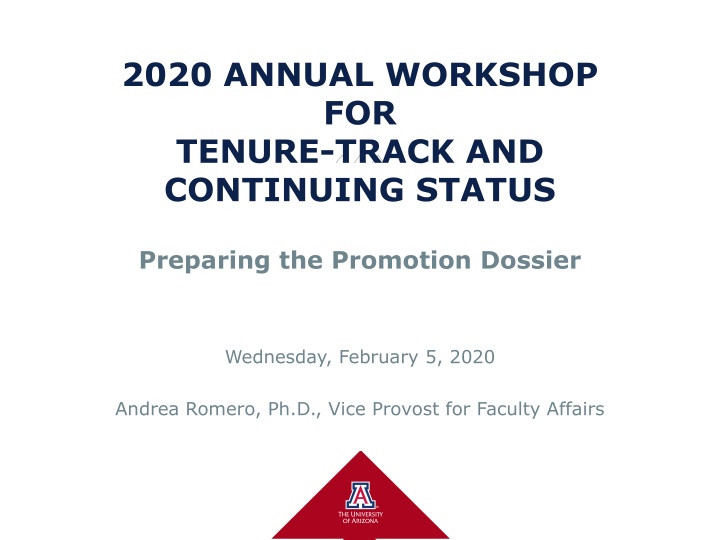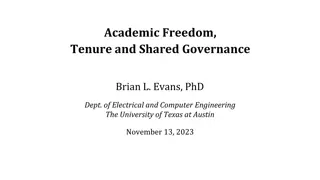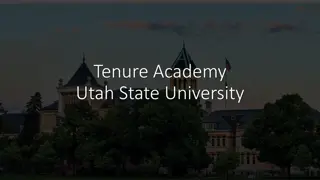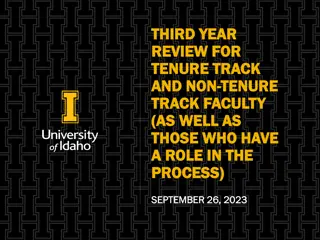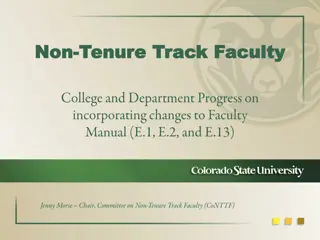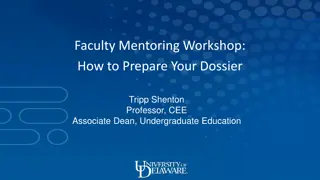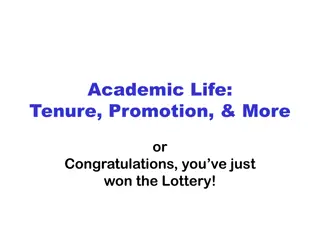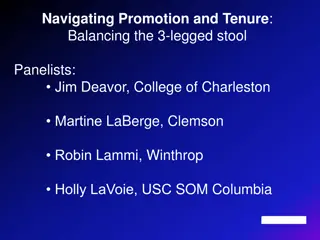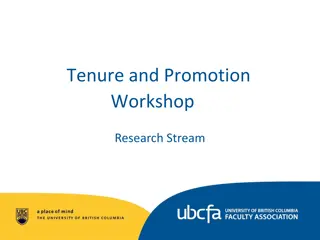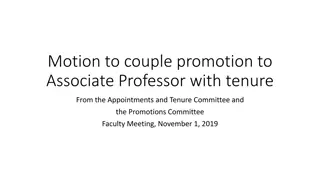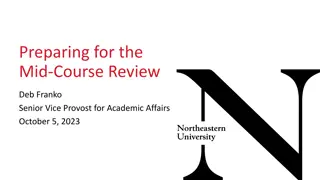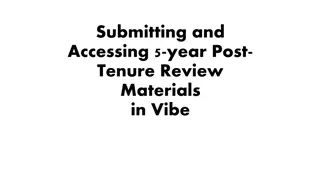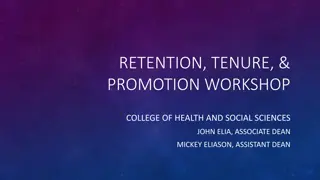Workshop on Preparing Promotion Dossier for Tenure-Track Faculty
Annual workshop led by Andrea Romero, Vice Provost for Faculty Affairs, at the University of Arizona discussing the promotion review process for tenure-track and continuing status faculty. The workshop covers topics like evaluation of teaching, promotion dossier preparation, and tenure-clock delay requests. Attendees can also access spring 2020 workshops and resources on promotion policies and faculty affairs.
Download Presentation

Please find below an Image/Link to download the presentation.
The content on the website is provided AS IS for your information and personal use only. It may not be sold, licensed, or shared on other websites without obtaining consent from the author.If you encounter any issues during the download, it is possible that the publisher has removed the file from their server.
You are allowed to download the files provided on this website for personal or commercial use, subject to the condition that they are used lawfully. All files are the property of their respective owners.
The content on the website is provided AS IS for your information and personal use only. It may not be sold, licensed, or shared on other websites without obtaining consent from the author.
E N D
Presentation Transcript
2020 ANNUAL WORKSHOP FOR TENURE-TRACK AND CONTINUING STATUS Preparing the Promotion Dossier Wednesday, February 5, 2020 Andrea Romero, Ph.D., Vice Provost for Faculty Affairs
Agenda Introductions The Promotion Review Process Tenure-Track Continuing Status Track The Promotion Dossier Evaluation of Teaching Provost Award for Innovations in Teaching
Introductions Andrea Romero Vice Provost for Faculty Affairs Professor Family Studies & Human Development (affiliated with Psychology, Mexican American Studies, Gender and Women Studies, and Public Health) 20 years at University of Arizona When do you go up for review? For what rank/status? What is your strength? What is your concern? What question do you have about the process?
Spring 2020 Workshops & Handouts Watch recording of Making a Statement for Promotion Workshop at: Here Slides available here Preparing for Promotion on the Career-track Tuesday February 11th, 3:30-4:45 p.m. Harvill 305 Zoom available Teaching & Service Portfolios that Document Impact, Innovation and Leadership Tuesday February 18th, 12:30-1:50 p.m. Old Main Silver & Sage Zoom available Happiness & Life-Work Balance Wednesday February 19th 1:30-3p.m. Student Union Kiva Auditorium Provost Folks, featuring: Dr. Celestino Fernandez, Small Group Discussion Going Up for Full Wednesday February 26th, 9:30-10:50 a.m. Old Mail Silver & Sage Zoom Available
Promotion Policy and Faculty Affairs Resources University Handbook for Appointed Personnel Tenure-Track Chapter 3.3 Continuing Status Chapter 4A.3 Faculty Affairs Website Resources https://facultyaffairs.arizona.edu /content/about-promotion Inclusive View of Scholarship Guide to Promotion Promotion Clock Promotion Criteria Continuing Status & Promotion Promotion & Tenure Promotion and Career-track Faculty Promotion Workshops
Requesting Tenure-Clock Delays in Reviews Submit requests at least one semester before the review. Prestigious External Commitments that take time away from research Birth or Adoption Personal Reasons such as personal health or family or partner health and care Adverse Professional Circumstances that are beyond the candidate s control
The Promotion Process for Candidates Meet with Department Head Spring before Confirm and discuss first page, workload page Share candidate s list of external reviewers or those not to be contacted Agree on deadline for submission of materials Attend Promotion Workshops Prepare Dossier CV Candidate Statement Teaching Materials Additional materials for department head (publications, teaching materials (syllabi, examples of student work), service materials (thank you, etc.) Receive letter from Department Head Fall Receive letter from Dean Early Spring Receive letter from University last Friday of April
The Promotion Review Process Levels of Reviews External Reviews Department Review College Review University Review University Committee College Committee Department Committee Provost Dean Department Head or Director
Administrator Notifications to Candidates Candidates are notified by the department head or director and dean when their dossier has moved forward to the next level of the review. This is required for candidates under review. The written notifications to the candidate can be included in the dossier. Review the policy in the University Handbook for Appointed Personnel (UHAP) 3.3.02C, for more information.
Additions to Dossiers? Up to February 1, additions may be made (for example, a major grant or publication). However, the addition must be requested by an administrator or committee chair. Additions require re-review at earlier levels. Candidate must be informed. Candidate must be given chance to respond if the information is negative (such as poor teaching evaluations).
Appeals of Promotion Decisions The Provost s decision may be appealed, as detailed in UHAP 3.3.02.e and UHAP 4A.3.02. Appeals to the President must be made in writing within 30 days of the Provost s decision. Access to redacted dossier is provided following the Provost s Office protocol. The President s decision is final, except in cases of discrimination or unconstitutional violations of due process.
Protect the Process to Ensure Fair Reviews External and internal reviewers cannot be collaborators. Use Collaborator Letters from those who are not independent. Process and voting is CONFIDENTIAL Notify Candidates about teaching reviews and when forwarding dossiers. Follow the Guide to the Promotion Process. Consult with your department head, dean or the Provost s Office on procedural variations or questions. Follow formats in Dossier Template Promotion review committee training that includes implicit bias training
UHAP 7.01 Professional Conduct Inclusive & respectful Value all voices Integrity and established standards Fairness & honesty, avoid conflict of interest Good stewards of university resources Safe environment for all who work with us No discrimination, harassment, intimidation, inclusive Academic freedom and freedom of speech Opposing views, critical thinking, scholarly rigor Instructional commitment Curiosity, student belief in their own ability Commitments to research, scholarship & creative activities New knowledge that challenges our thinking Service and outreach commitments http://policy.arizona.edu/sites/default/files/uploads/UH AP%207.01%20Professional%20Conduct.pdf
Evaluation Workload Distribution Unit Criteria for Promotion Each unit has their own unique promotion guidelines that clarify what is considered of value within their field and what is typical in terms of workload, teaching, and service at each rank. College Criteria for Promotion Inclusive Scholarship The University values an inclusive view of scholarship in the recognition that knowledge is acquired and advanced through discovery, integration, application, and teaching. The University values collaboration among colleagues, both externally and internally, and the candidate's contributions to such collaborations will be considered in promotion reviews. Depending on the assigned duties of individual candidates and the criteria of their departments and colleges, promotion reviews may consider original research contributions in peer-reviewed publications as well as integrative and applied forms of scholarship that involve cross- cutting collaborations with business and community partners, including translational research, commercialization activities, and patents. https://facultyaffairs.arizona.edu/content/universitys-inclusive-view- scholarship
Candidate Choice of External Reviewers Provide department head the name, rank, institution, email, short bio, and reason for choosing Experts in your field (3-4) Leave some names for your department head to choose Consider interdisciplinary representation Rank above your own current rank Peer institutions is a key consideration Arms-length No co-authors (any published work, abstracts, grant proposals within 5 years before submission of dossier) No co-investigators or consultants on grants No previous mentors or advisors Editors of journals or books are ok
Peer Institutions: https://uair.arizona.edu/content/ua-peers INSTITUTION The University of Arizona Arizona State University University of California, Berkeley University of California, Davis University of California, Los Angeles Stanford University University of Southern California University of Colorado, Boulder University of Florida University of Illinois at Urbana-Champaign University of Iowa University of Maryland, College Park Michigan State University AAU X MED SCHOOL X PAC 12 X X X LAND-GRANT X X X X X X X X X X X X X X X X X X X X X X X X X X X X X X University of Minnesota, Twin Cities X X X University of North Carolina at Chapel Hill Ohio State University University of Oregon Oregon State University Pennsylvania State University University of Texas at Austin Texas A&M University University of Utah University of Washington Washington State University University of Wisconsin, Madison X X X X X X X X X X X X X X X X X X X X X X X X X
External Reviewers Solicited by the Department Head or the Committee Chair. External Reviewers MUST be independent and at or above the rank the candidateis being reviewed for promotion. Use the required template for requesting letters. Include all solicited letters. Only head or committee chair should contact outside reviewers. Submit brief bios of external reviewers, not CVs. Experts at peer institutions. No more than half can come from candidate s list. Document the selection process.
Collaborator Letters Collaborators include Very helpful if engaged in large collaborations (they can speak to your role and quality of collaboration or your expertise) Very helpful to represent view of non-academic partners Co-authors on scholarship or grant proposals within 5 years of the dossier submission Collaborators include Dissertation advisors, Supervisors Close co-worker in lab, department, or residency program Collaborators on book editing or journal editing projects
Distinctive Aspects of Continuing-Status Reviews CS reviews consider position effectiveness as well as teaching, research & service. Thus, the job description and allocation of time are even more important. Work with your supervisor to align your duties with your unit s guidelines for promotion, and Make sure to document your contributions to publications and grants. Finally, develop an assessment plan to demonstrate the impact of your activities.
The Promotion Dossier 2020-21 Review Templates will be available by March 1st, 2020
The Promotion Dossier Section # Title Prepared By Section 1: Summary Data Sheet Dept. Administration Dept. Admin, Head/Director & Candidate Section 2: Summary of Candidate's Workload of Assignment Section 3: Dept. & College Criteria (not the full guide) Dept. Administration Section 4: Curriculum Vitae & List of Collaborators Candidate Section 5: Candidate Statement Candidate Section 6: Teaching Portfolio Candidate Evaluation of Teaching & Recommendation for Provost Award Section 7: Dept. Committee Section 8: Portfolio to Document Leadership in Service & Outreach Candidate Candidate, GIDP Chair & Dept. Committee Section 9: Membership in Graduate Interdisciplinary Programs Dept. Administration, Committee Chair & Head/Director Section 10: Letter from Outside Evaluators & Collaborators Section 11: Recommendations (from Internal Reviewers) Dept., College & Univ. Levels Refer to the Guide for tips on preparing dossiers
SECTION 1: SUMMARY DATA SHEET https://facultyaffairs.arizona.edu/sites/default/fi les/2019- 20_01_PT_Summary%20Data%20Sheet.pdf
Section 2: Workload Assignment Prepared by the Department Head The Workload Assignment should be kept current and accurate. Use percentages and define meaning 40% teaching, which means ... number of courses 40% research, which means ... 20% service, which means ... Describe duties, do not praise achievements. Use the template provided in the dossier. Electronic signatures are acceptable.
Your Job Description Sets the Expectations for Review Explain your contributions in non-technical terms. Include all job descriptions and note changes. Often job descriptions include statements of duties that are used to assess position effectiveness. Duties may include the following categories: Research/Scholarship/Creative Activity, Outreach/Service, Teaching/Educational Outreach, and Position Effectiveness Clinical Service Administrative Service Extension
Specify your Duties Accurately Workload areas CALS CALS Curator Librarian Research/scholarship/ creative activity 40% 10% 40% 20% Extension 70% Teaching 40% Service/Outreach 20% 20% 60% 10% Professional activities 70% Totals 100 100 100 100 If you select Other Professional Activities, list and specify the duties. DESCRIPTIONS DO NOT INCLUDE EVALUATION.
Section 3 Department and College Promotion Criteria Set criteria for review for your discipline/unit
Sections 4: CV Documenting Your Activities Follow the required CV format exactly. TEMPLATES VARY BY TRACK PROMOTION & TENURE TRACK CONTINUING STATUS AND PROMOTION TRACK CAREER-TRACK PROMOTION Get models for CVs from others in your department and your field Review your records of service and teaching contributions. Service break out by subsections Teaching Mentoring and student outcome in tables
Section 4: Curriculum Vitae and List of Collaborators Follow format and organization Chronology of Education Chronology of Employment Honors & Awards Service/Outreach Publications/Creative Activity Works in Progress Media Conferences/Scholarly Presentations Awarded Grants & Contracts List of Collaborators and Affiliations
Section 5: Candidate Statement Tell the Story of Your Achievements and Impact No More than 5 pages Use the Candidate Statement to Characterize your research and teaching Reflect on what you do and how you do it Connect with teaching and service dossiers; and Thereby demonstrate the impact of your work. Audience Experts in your field, department committee, department head, college committee, dean, university committee What do they need to know that is not clear in your CV? First paragraph and last paragraph matter (position your work and key things that you are known for)
Using Your Candidate Statement to Represent Your Scholarship What is your scholarship? What is innovative? Which pieces have had the greatest impact? How do your research grants fit in? Role What has been your role/contribution on key papers or grants Themes Research Questions and how your work answers them Not necessarily chronological Organize by impact/innovation Research your own work Progression of work Independence Mentorship and success of grad students Impact: What is the impact of your scholarship on your field? What are common benchmarks in your field that help reviewers understand your impact Innovation How is your creative work advancing the current field? Be specific
Using Your Candidate Statement to Represent Your Teaching What do you teach, and who are your students? How do you use active learning strategies? How do you assess their progress? Goals: Learning Outcomes Student Engagement Interpersonal dynamics Methods: Curricular design Modes of instruction Context Management Link with CV Connect text to class, refer to CV teaching portfolio examples Assessment and Impact: In-class student feedback Peer assessments TCE reports Letters from students Broader contributions
Evaluation of Teaching Office of Instruction and Assessment
Holistic Evaluation of Teaching Best Practice focus on multiple sources of teaching quality Student surveys TCE reports generated by department coordinator and given to P & T Committee, candidates do NOT need to provide their TCE reports Candidates may choose to summarize their TCE reports and student comments as part of their candidate statement Peer observation Course Materials Teaching Statement (within candidate statement) Evidence-based learning strategies Inclusive curricula and classrooms Extent of Teaching Courses taught during time in rank Individual Student contact Instructional Innovation and Collaborations Teaching Awards & Teaching Grants Supporting Documentation Syllabi and major assignments Curricular reviews and other contributions
Section 6: The Teaching Portfolio The Candidate Statement sets up the Portfolio. Supporting Instructional materials (such as syllabi, slide presentations, class assignments, student project, and curricular reports) stay at the department-level of the review. Information on Teaching and Advising will be forwarded past department Document advising and mentoring. Additional resources
TCE/SCS Consultation & Support Services Assistance to committees and faculty accessing & interpreting TCEs. Contact: Rebecca P rez Assistant Director, Instructional Data Office of Instruction and Assessment rperez@email.arizona.edu and 520-626-0536
Section 7: Evaluating Teaching DONE BY PEER REVIEW COMMITTEE A memo with a peer review of the teaching is required, in addition to the general department letter. This memo includes: a summary of teaching observation(s), a review of student evaluations and TCE scores with a discussion of comparison to faculty, and an assessment of the Teaching Portfolio (section 6) Use Peer Review of Teaching Protocol to conduct at least one (within 1 year) teaching observation. Summarize TCE reports and obtain independent student commentsfrom your department s TCE representative. NEWCommittee s summary of TCE scores is included in this section and not the TCE reports.
Section 7: Recommendation for Provost Award DONE BY PEER REVIEW COMMITTEE Committees write a separate memo to recommend candidates for the Provost Award for Innovations in Teaching. Award criteria: innovative teaching strategies active learning strategies and other evidence-based instructional practices well-structured course syllabi with well-defined learning outcomes inclusive teaching strategies and course content to address diverse learning styles and experiences involvement in workshops and collaborative reforms of teaching strong TCE and student comments teaching awards, grants, and other recognized achievements in teaching effective mentoring and advising, including collaborations with students from diverse backgrounds.
8: Service and Outreach Portfolio This section is an option for P&T candidates, but all candidates should discuss the impact of their service. This section may be required for continuing status reviews that include educational outreach or have it as a key component of their workload. In P&T reviews, these materials remain in departments. What to Include? Technical reports, research studies, and presentations Articles for popular publications and instructional materials, What to include in the dossier to document impact? Letters from community collaborators noting impact Letters from research collaborators noting rigor and innovation News reports on service contributions Adoptions of programs and materials by other institutions
8: Service and Outreach Portfolio Collaborations with business and community partners, tech transfer, commercialization activities, translational research Program Overview Description of program Assessment of program Supplementary Documentation Supporting Docs Expert testimony or consultations On-line resources for community, business, agency, or disciplinary associations Newsletters, pamphlets or articles for popular or special interest publications Technical reports or materials Documentation of Impact Letters from community/business collaborators with emphasis on impact of programs Letters from academic collaborators noting impact/rigor of contributions News reports Adoption of programs or materials by other institutions or groups
Additional Information Checklist for shared appointments Section 9: membership in graduate or other interdisciplinary programs Candidate description of GIDP membership or interdisciplinary programs/initiatives Chairperson of GIDP evaluation of candidate contribution Department Committee summary/evaluation of candidate contributions to GIDP
Use Your Dossier to Document Your Impact Address non-specialists as well as experts. Make sure your head or committee chair understands who would be appropriate reviewers. Use the Candidate Statement and to discuss the progress and impact of your program of work. Discuss soliciting collaborator letters to document the impacts of your work. Document your efforts to improve your teaching. Consider asking graduates and former students for letters. Use the Service and Outreach Portfolio to document your leadership contributions.
2020-2021 Candidates: Just FYI NO NEED TO USE THIS YEAR On your first UA Vitae login, you will be asked if you want to go to your Dossier account or to the institutional products from Interfolio. Simply choose which area you would like to proceed Dossier space is your private space.
The Promotion Process Department creates P & T Committee the Spring before review Peer Observation of candidate using OIA form Teaching Summary Memo Nomination for Provost Innovation in Teaching Develop list of external reviewers (with input from candidate and sometimes with input from review committee) Department Head contacts external reviewers early No more than half of letters can be nominated by candidate Must be arms-length 3-8 external reviewer letters Department gives candidate deadline for submission of complete dossier. First Page- Candidate and Department Head Workload and summary Department Head
The Faculty Affairs Team Facultyaffairs.Arizona.edu
